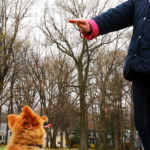Are you looking for effective crate training techniques for your Pomeranian?
A crate can be a great tool to help your pup become comfortable in their space and learn to be house trained.
With the right approach, you can help your pup become comfortable with crate time and create a positive experience.
Follow these steps to begin crate training your Pomeranian and ensure that your pup is safe, secure, and content.
Key Takeaways
- Choose a crate that is the right size and material for your Pomeranian, ensuring it is comfortable and easy to clean.
- Create a cozy and quiet environment inside the crate with a soft bed and breathable bedding.
- Gradually introduce the crate to your Pomeranian, using positive reinforcement and establishing clear expectations.
- Use the crate for feeding and mealtime, and gradually increase the amount of time your Pomeranian spends in the crate for successful training.
Choosing the Right Crate for Your Pomeranian
When selecting the right crate for your Pomeranian, it’s important to consider size, material, and ease of use. Proper sizing is essential in order to ensure your pup’s safety and comfort. The crate should be large enough for your Pomeranian to move around in and lie down, but not too big that they’re overwhelmed.
The material should be durable and easy to clean, and the crate should be lightweight enough for you to move. Where you place the crate is also important; pick a quiet, low-traffic area, such as a corner of a room. This will help your pup feel secure and provide an area that’s solely theirs.
Making Crate Time Comfortable With Bedding
Adding a soft, cozy bed to your Pomeranian’s crate will make their crate time much more comfortable. When selecting a blanket, choose one that’s made of a breathable fabric, such as cotton. It should be large enough to fill the base of the crate and provide your pup with enough space to move around.
Additionally, consider the crate’s location. Place it in a quiet area of your home, away from too much noise or distraction. This will help your pup feel safe and secure in their crate. Additionally, ensure the crate is in a warm area and away from drafts.
With the right bedding and crate setup, your Pomeranian will be comfortable and enjoy their crate time.
Gradually Introducing the Crate
It is important to explain your expectations of crate training to your Pomeranian and establish a routine so that they gradually become comfortable with the crate.
Start with simply showing them the crate and give them treats and praise when they go near it. Show your Pomeranian that the crate is a positive and safe environment.
Explain Expectations
Explaining expectations and gradually introducing your Pomeranian to a crate can help ensure successful crate training. Designate boundaries for your pup and reward consistency when they obey. Here are some tips for explaining expectations:
- Provide clear, consistent commands and use positive reinforcement.
- Establish a routine so your pup knows when and where to go.
- Have patience and remember that it’s a process.
Establish Routine
Establishing a routine with your Pomeranian is key to crate training success. Start by familiarizing them with the environment, such as the crate, and building trust with them. This should be done gradually, allowing your dog to explore and become comfortable with the crate. If you rush the process, your Pomeranian may become scared or anxious.
First, keep the door of the crate open and let your pup get used to the sight and smell. You can also offer treats or toys to encourage them to enter and explore. Once they’re familiar with the space, you can start adding a few minutes of confinement at a time and slowly increase the duration.
Don’t rush the process or your pup may develop an aversion to the crate. By taking the time to introduce the crate and establish a routine, you’ll create a positive experience for your Pomeranian.
Feeding Meals in the Crate
You can help your Pomeranian adjust to being in their crate by feeding them meals inside it. Offering treats, such as their favorite snack or chew toy, will create a positive association with the crate. This will help them feel more comfortable being in it.
To further reinforce the idea, it’s important to establish rules about when and where they’re allowed to eat. This will help your Pomeranian understand that the crate is a place of safety and security.
To make this process easier, you can:
- Keep the feeding routine consistent
- Provide regular meals in the crate
- Offer treats or food puzzles inside the crate
Creating an environment where your Pomeranian feels secure and comfortable is key to a successful crate training experience. Establishing rules and offering treats will make the process easier for you and your furry friend.
Varying the Length of Crate Time
Varying the length of crate time can help your Pomeranian become comfortable with their crate. Start with short sessions of a few minutes and gradually increase the length of time.
This will allow your Pomeranian to adjust to the crate and create a positive association with it.
Timing Variation
You’ll want to vary the length of time spent in the crate to help your Pomeranian adjust. Crate time should be tailored to your pup’s individual needs and capability.
Here are some tips to consider when varying the length of crate time:
- Offer positive reinforcement each time they enter and exit the crate.
- Create a safe environment that’s comfortable and secure.
- Start with shorter periods of time and gradually increase the length as your pup becomes more used to the crate.
By varying the length of time spent in the crate, you can create a successful and rewarding crate training experience for your pup. The key is to be consistent and patient, and to provide lots of love and encouragement.
With these simple tips, you can create a positive environment that helps your Pomeranian adjust to the crate in no time.
Short Sessions
Try breaking up your pup’s crate time into shorter sessions to help them adjust. This will allow them to feel more comfortable in their crate and better acclimate to the training. To make this method successful, be sure to use positive reinforcement and reward treats each time the pup is in the crate. Doing this will encourage them to enjoy their time in the crate and see it as a positive experience.
After each session, be sure to provide your pup with fresh water, a toy, and a few minutes to stretch and wander in a safe space. By varying the length of time in the crate, your pup will be better prepared to stay in the crate when needed without feeling anxious or overwhelmed.
Crate Time Should Never Be Punishment
Never punish your Pomeranian for spending time in the crate. Crate training should be a positive experience and should be done with patience and positive reinforcement. Crate training should be part of a structured schedule that your Pomeranian can follow.
Here are some tips to keep in mind to ensure that crate time is a positive experience:
- Provide your Pomeranian with plenty of toys and treats for when he’s in the crate.
- Offer plenty of positive reinforcement when he goes into the crate.
- Make sure that your Pomeranian has enough space to move around and be comfortable.
Rewarding Crate Time
You’ll want to reward your Pomeranian whenever he spends time in the crate, as this will encourage him to continue doing so.
Positive reinforcement is the key to effective crate training, and it’s essential to form a positive association with the crate. Offer your pet treats, toys, or verbal praise when he enters the crate, and only when he’s in the crate. This will help him realize that the crate is a safe and enjoyable place.
You can also give him a special treat or toy when he goes into the crate and leave it in there for him to enjoy while he’s in it. Over time, your Pomeranian will form a positive association with the crate and will be more likely to enter and stay in it.
Building Crate Time During the Day and Overnight Training
Start building up your Pomeranian’s crate time during the day, and then move on to overnight training. To ensure success, use positive reinforcement rewards, such as treats when your pup first enters the crate. Additionally, try soothing and calming music to help your pup relax and be more comfortable.
Here are some tips to get the most out of crate training:
- Provide a safe and comfortable environment to encourage your Pomeranian to explore and relax in the crate.
- Provide treats and/or toys in the crate, and praise your pup when they enter.
- Use positive reinforcement consistently when your pup is in or near the crate.
Frequently Asked Questions
What Is the Best Age to Start Crate Training?
Starting crate training at an early age is key. Use positive reinforcement and make sure the crate is the right size. This will help your pup become comfortable and help establish good behavior.
How Can I Get My Pomeranian to Stop Barking in the Crate?
Reward your Pomeranian with positive reinforcement when they remain quiet in the crate. A reward system will help them understand that staying quiet will be beneficial. Offer treats or praise as a reward for good behavior.
Are There Any Health Risks Associated With Crate Training?
When crate training, be mindful of crate size; too small can cause discomfort and health issues. Training duration should also be considered; too long can lead to boredom and stress. Take appropriate precautions to ensure your pup’s health and safety.
What Should I Do if My Pomeranian Doesn’t Seem to Be Responding to the Crate Training?
If your pup isn’t responding to crate training, try reward based training and positive reinforcement. Encourage your pup with treats and verbal praise to give positive associations with the crate. Be patient and consistent, and your pup will soon be happily crate trained!
How Do I Know When My Pomeranian Is Ready to Stay in the Crate Overnight?
When your Pomeranian begins responding positively to the crate training, showing signs of comfort and responding to your commands through positive reinforcement and consistency in your schedule, they may be ready to stay in the crate overnight.
Conclusion
Crate training your Pomeranian doesn’t have to be difficult. With the right crate, comfortable bedding, and gradual introduction to the crate, you can make the process easier and more enjoyable for both you and your pup.
And don’t forget to reward your pup for spending time in the crate! With these effective techniques, you can have a well-trained pup in no time.






